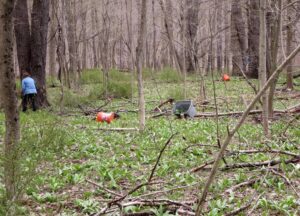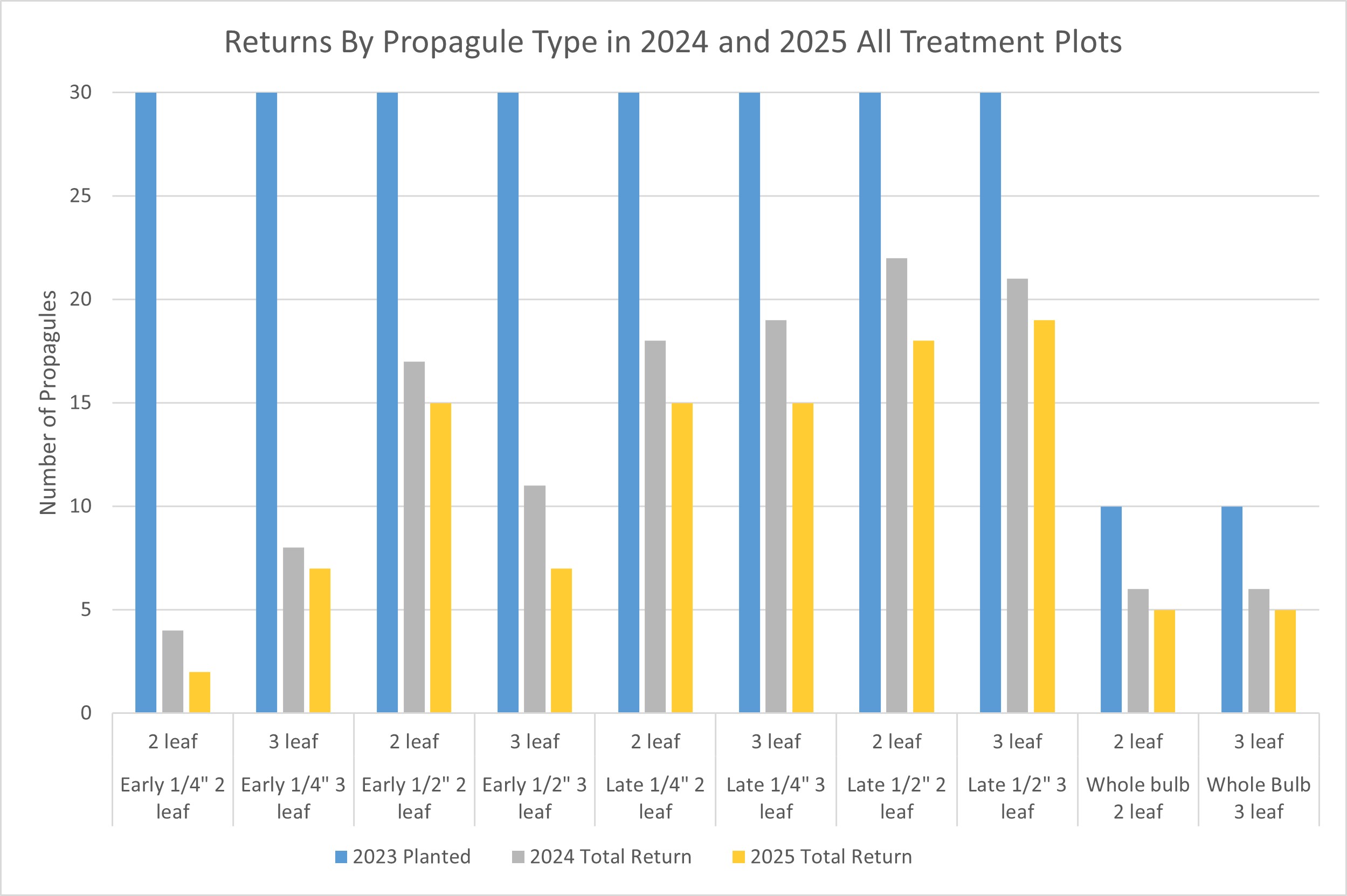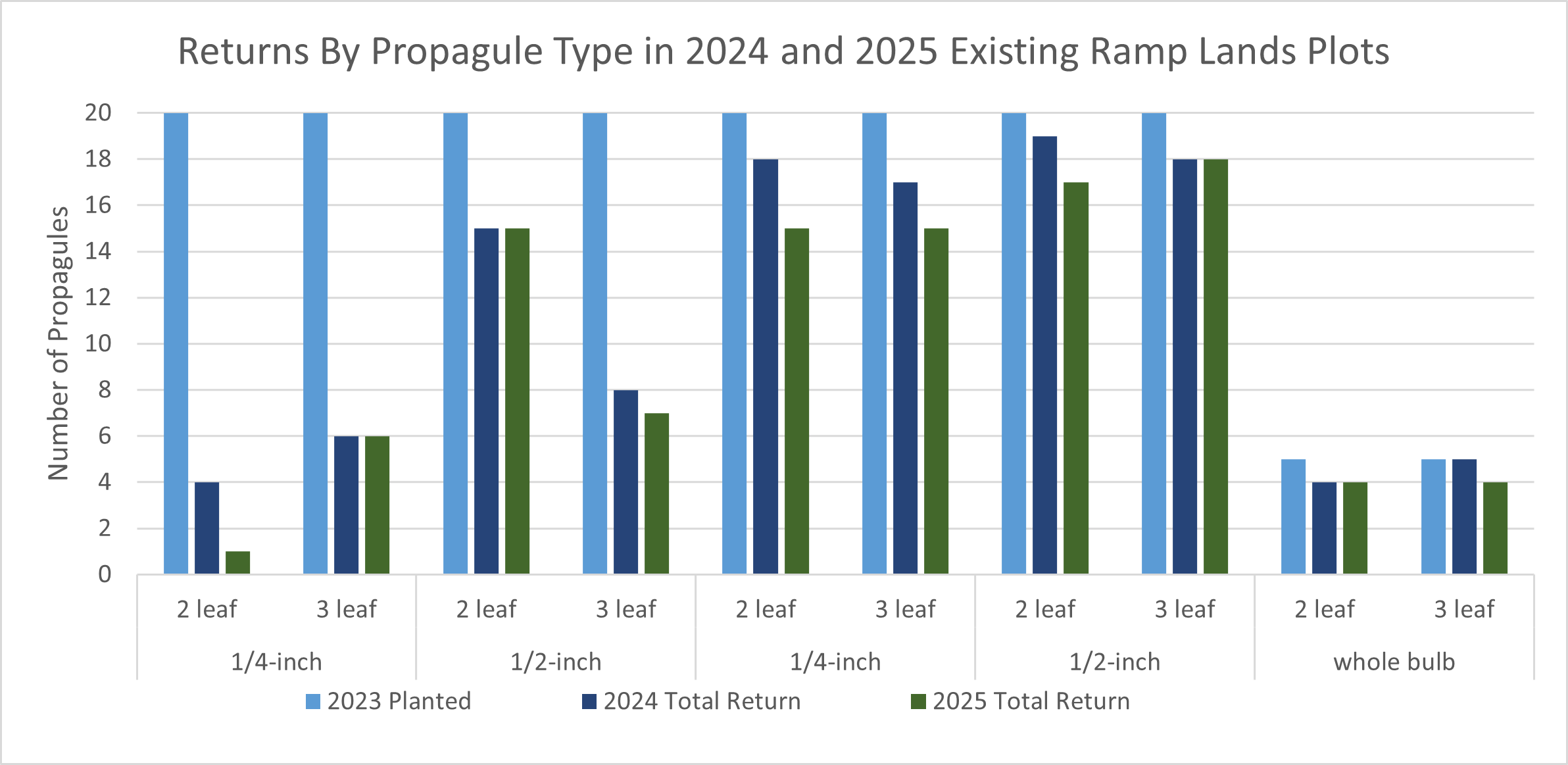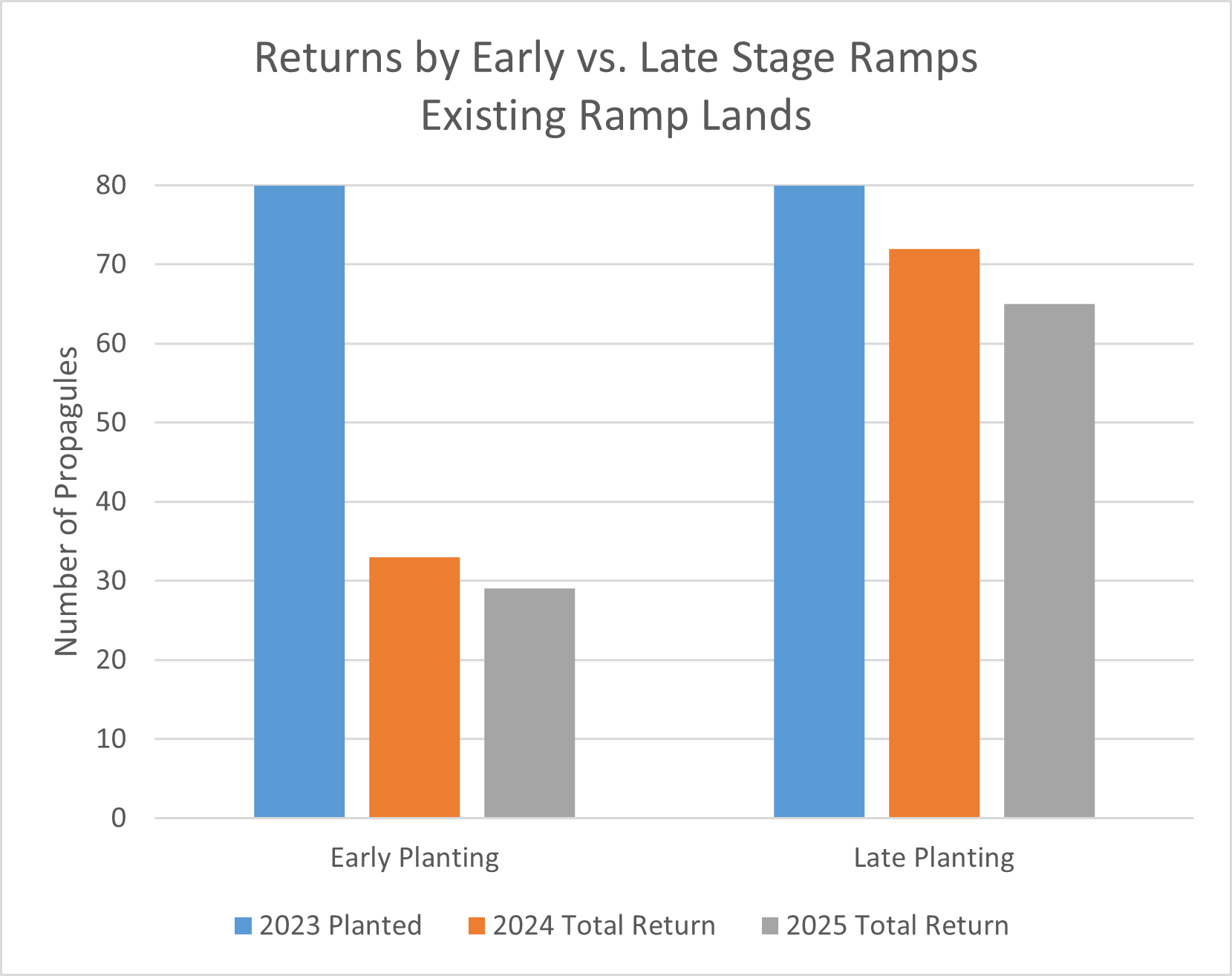Final report for FNE23-067
Project Information
This project explored the feasibility of transplanting the root plates of ramps (Allium tricoccum, wild leeks) with a small segment of bulb attached. Treatments varied the maturity of the plant from which the propagule was taken, the size of the bulb segment, the number of leaves of the plant and the color of the stem. No experimental variables resulted in complete failure. All replants yielded at least some success, suggesting that bulb base replanting could be a viable and successful means of propagating ramps. Success is improved when the following practices are followed: (1) bulbs should be allowed to “size up” during the spring months resulting in larger planting propagules; and (2) propagule (bulb) replant pieces should be 1/2-inch long. Results were shared with students and farmers through powerpoint presentations, webinars and on-site workshops.
This project seeks to determine the viability of planting new ramp beds or augmenting existing beds by transplanting the portion of the plant not used in culinary applications - the root plate. The project will test the timing of harvest, the size and numbrt of leaves of the harvested plant, and the amount of propagule transplanted over multiple beds in both existing and new ramp lands.
Metrics include the number of surviving transplants, the number of leaves, the length and width of the leaves, and the weight of the plant. In the third year of the study (the second growing season after transplanting the propagules) the metrics include whether the plant shows signs of producing flowers and seeds.
A similar study is being conducted by Dr. Eric Burkhart of Penn State University with many of the key parameters replicated.
It is expected that the results will be able to be statistically analyzed to determine the optimum treatment method.
As the popularity of ramps has increased and a commercial market has been established, every year leading up to ramp season there are articles in the NY Times and other publications declaring that ramps are in danger of being overharvested or even exterminated. As a sustainable ramp producer on my own private lands, I get calls and emails from family, friends and customers with concern. While we have established a practice of harvesting a sustainable number of whole plants for sale each year combined with long-term managing the forest ramp lands for tree canopy and understory we are aware of the issue on public lands and remote private lands.
The sustainability of wild populations of ramps has been questioned and addressed in previous research. Most research has focused on overharvesting on public lands. Previous research has sought to quantify the number of plants/area that constitute a sustainable population (Population Viability Analysis of American Ginseng and Wild Leek Harvested in Stochastic Environments by Patrick Nantel, Daniel Gagnon and Andree Nault) and the frequency of harvest/area that ensures sustainability (Population recovery following differential harvesting of Allium tricoccum Ait. in the southern Appalachians by Janet H. Rocka, Brian Beckage and Louis J. Gross ).
Other research has been conducted into optimal habitats including tree species composition and soil characteristics and tested soil amendments in managed ramp populations (Response of Woodland-planted Ramps to Surface-applied Calcium, Planting Density, and Bulb Preparation by K. Dale Ritchey and Carol M. Schumann).
Limited research has been conducted on planting of ramp bulbs and seeds to augment existing populations and establish new populations (SURVIVAL AND GROWTH OF Allium tricoccum AIT. TRANSPLANTS IN DIFFERENT HABITATS by Liette Vasseur & Daniel Gagnon) and this has been demonstrated to be one way to augment sustainability.
We tested a different approach. In commercial and consumer ramp processing, leaves are often trimmed to use in one set of preparations and bulbs are trimmed of their root plate to use in other preparations. The root plate is then discarded. Some have suggested that the root plate may contain enough viable material to regenerate into a plant that can subsequently be harvested or left to mature into its reproductive state in 4 to 5 years. To our knowledge, this practice has not been scientifically studied.
We do have some experience trying this method ad hoc. Towards the end of every ramp season when leaves start to senesce, we offer to our customers "ramp bulbs only" at a much higher price to account for the labor of trimming the leaves and root plates and delivering bulbs ready to cook. Many times we have replanted the root plates in a quick manner without regard to the number of plants or the size of the propagule planted. We have seen some regrowth with this ad hoc method.
We systemically tested this method to determine the amount of bulb material required to be retained with the root plate and the time of harvest to find the best practice for viability. The study was designed to cover two growing seasons to explore not only whether the plants regrow from the root plates but also whether they begin to approach their reproductive state by growing three leaves and possibly generating a flower spike by the second growing season.
No experimental variables resulted in complete failure. All replants yielded at least some success, suggesting that bulb base replanting could be a viable and successful means of propagating ramps.
We have been sharing the study in process and plan to share the final results and conclusions with the ramp community as well as end-consumers to get out the message that they can "plant their ramps and eat them too".
Delaware Valley Ramps has been in business since 2007, harvesting, processing and selling ramps and other wild forest edibles to markets in NYC, the Western Catskills and Northeast Pennsylvania. Our business specializes in marketing spring ephemerals and we are involved in outreach and education on our practices year-round. In addition to this SARE funded project we have been involved in other research on spring ephemerals with biologists from Penn State who utilize our property as one of their research sites.
The property consists of 20 mostly wooded acres on the Delaware River in NE Pennsylvania. Ramps grow prolifically on more than half of the property.
In 2021 we also instituted an experiential business called Ramps U-Pick where people come during ramp season to learn about the plant and its habitat, how to dig and process ramps, and then have the opportunity to harvest whole plants, bulbs or seeds for their own consumption or to transplant. Participants, who purchase tickets for a timed slot, are then offered several dishes made from ramps and are given recipes to take home and try on their own.
Cooperators
- - Technical Advisor (Educator and Researcher)
Research
Ramp Sustainability Trial - Replanting Root Plates
Research Activities
At the start of the project in the Spring of 2023, 6 study plots were established on Delaware Valley Ramps owned land. 3 of the plots are on existing ramps producing land and 3 of the plots are on land of a similar forested nature with appropriate tree canopy density, tree species mix and soil moisture where ramps have not naturally colonized.
Four of the plots measured 4 by 6 feet and were staked at the corners. Two of the plots are 4 by 8 feet. All ramp plants in the existing ramp producing lands were harvested when the plots were established so that there are no natural plants remaining. Surface brush was cleared from all plots but no further ground preparation was performed such as the removal of other species such as hay scented ferns.
Four of the plots were divided into 8 sections (see plot design diagram under Other Relevant Research Information below). Each section was labeled with a permanent marker and photographed. Two of the plots were divided into 10 sections.
To test the timing of harvesting and transplantation, 4 of the sections compare the outcomes for early harvested plants (which we describe as pencil stage bulbs typically in the first or second week of the commercial harvest) with the outcomes from the late harvested plants (which we describe as teardrop stage bulbs typically in the third and fourth week of harvest).
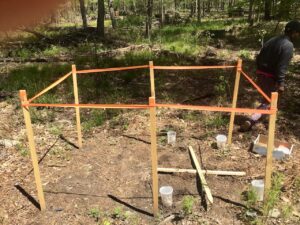
We further compare the outcomes for transplanting root plates from 2 vs. 3 leaf plants. Typically, plants that mature over 4 or 5 years to their reproductive age have 3 leaves though in some years where the plants are stressed we will see flowers and seed production from 2 leaf plants.
To test the optimal size of the propagule, 4 of the sections will further compare the outcomes for transplanting root plates with 1/4 inch of the bulb attached vs. root plates with 1/2 inch of the bulb attached. These will also further compare the outcomes for 2 vs. 3 leaf plants.
We also established 4 control plots by transplanted whole bulbs from late stage 2 and 3 leaved plants.
In addition, as a control, we added two sections in two plots (one in the ramp producing lands and one in the non-producing lands) and planted 5 full ramp bulbs and root plates in each of the sections.
Five propagules were planted in each section. A total of 260 transplants were completed, with 30 for each treatment and 20 for the controls.
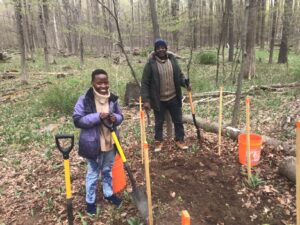
In the spring of 2023, transplants were harvested and segmented by leaf number at two times during the harvest, early and late. Prior to propagule preparation and planting a total of 83 whole plants were measured, weight and length as well as the weight of the propagules was recorded. This included 8 sample plants from each treatment and 19 of the whole bulb control plants.
The plants were then trimmed to the desired propagule size (1/4 or 1/2 inch of bulb attached). The resulting root plates were planted 2" below the soil level using a calibrated dibble. The plots were covered by raking forest duff to cover the transplants.
In the spring of 2024 after the ramps emerged, we counted the number of plants that have in each of the plots and each of the sections of each plot. We also recorded for each plant the number of leaves and whether any plant flowered or produced seeds.
In the spring of 2025 after the ramps emerged and developed, we recorded the number of plants and the number of leaves. In the fourth week of the ramp season, we harvested a few specimens, and measured leaf length and plant weight for each plant to compare to the original plants. Those specimens were then replanted in the same location. After the leaves had senesced in late June, we re-surveyed the plots to count the number of flowering plants. In late July we re-surveyed the plots to count the number of plants that had set seed.
Dr. Eric Burkhart of Penn State University replicated the study on Penn State forestlands at his Shavers Creek Environmental Center Environmental Center Forest farming research and education site in central Pennsylvania, varying the same parameters of early and late-stage ramps and propagule size. He further segmented the specimens by red vs. green stem but did not segment by the number of leaves.
The results of the study support our hypotheses that new plants can grow and mature into reproductive stage from replanting the root plate with a small segment of the bulb. All treatments exhibited returning plants while the most robust returns were for late-stage ramps with the largest bulb segments. These findings were replicated across both the Delaware Valley Ramps and PSU sites.
2025 Final Results
In 2025 we collected data for each of the 6 plots in 2025 as we did in 2024, during the height of the ramp season. We later surveyed the plots for flower and seed production after the leaves had senesced.
Overall, we found that there was good emergence across most of the treatments and plots though there were some diminishing returns between years 2024 and 2025. Results in 2025 ranged from 7% returns for early stage 2 leaved plants with 1/4" bulb on the propagule to 63% returns for late stage 3 leaved plants with 1/2" of bulb on the propagule. In 2024 the results ranged from 13% to 70% for the same treatments.
Delaware Valley Ramps Results for all treatment plots
Emergence was more successful in the 4 plots that were established among existing ramp lands (three of the trial plots were in existing productive ramp lands and one was in a transitional productive area where there were scattered patches) than in the 2 plots established in areas where there were no ramps. While the forest tree species are similar, the plots in the area where no ramps exist are has an understory dominated by hay scented ferns. These ferns were not removed prior to planting the propagules in 2023 and may have inhibited ramp emergence in 2024. These areas showed much fewer returning ramps, and will be further discussed below, so the following data discussion is confined to the four productive plots and titled Existing Ramp Land Plots.
The 2025 data for these 4 plots ranged from 5% returns for early stage 2 leaved plants with 1/4" bulb on the propagule to 90% returns for late stage 3 leaved plants with 1/2" of bulb on the propagule. In 2024 the results ranged from 20% to 90% for the same treatments.
Delaware Valley Ramps Results for existing ramp lands treatment plots
PSU planted all of their propagules in prepared beds where other ramp trials are taking place. The results of the PSU replicated study were similar with later stage propagules showing better returns. PSU results in 2025 (combining the red and green stemmed plants results) ranged from 18% returns for early stage 2 leaved plants with 1/4" bulb on the propagule to 78% returns for late stage 3 leaved plants with 1/2" of bulb on the propagule. PSU also saw diminishing returns in 2025 over 2024. In 2024 the results ranged from 27% to 92% for the same treatments.
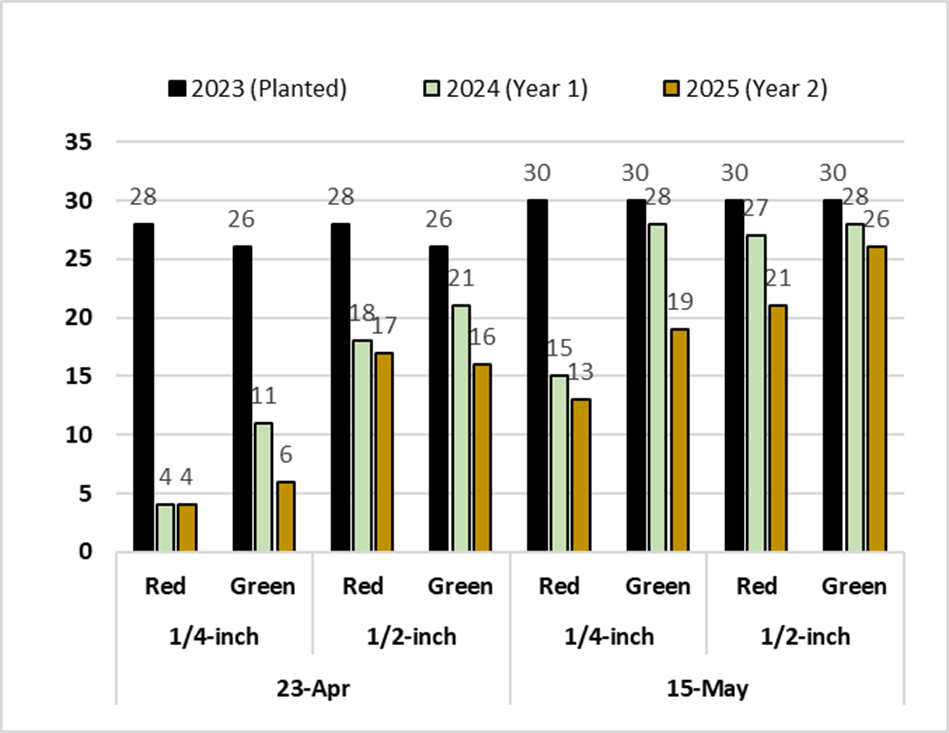
As expected, propagules from more mature plants with the larger propagule bulb segment (1/2") harvested later in the season produces the highest percentage of emergence. On existing ramp lands at Delaware Valley Ramps early-stage ramps had 36% returns and late-stage ramps had 81% returns. There was an insignificant diminishment of returns in 2025 over 2024 for both.
Delaware Valley Ramps Results for returns by early vs. late-stage plant propagules for existing ramp lands treatment plots
PSU also found that propagules from late stage plants had better returns with early-stage ramps showing a 40% return in 2025 (down from 50% in 2024) and late-stage ramps showing a 65% return (down from 82% in 2024).
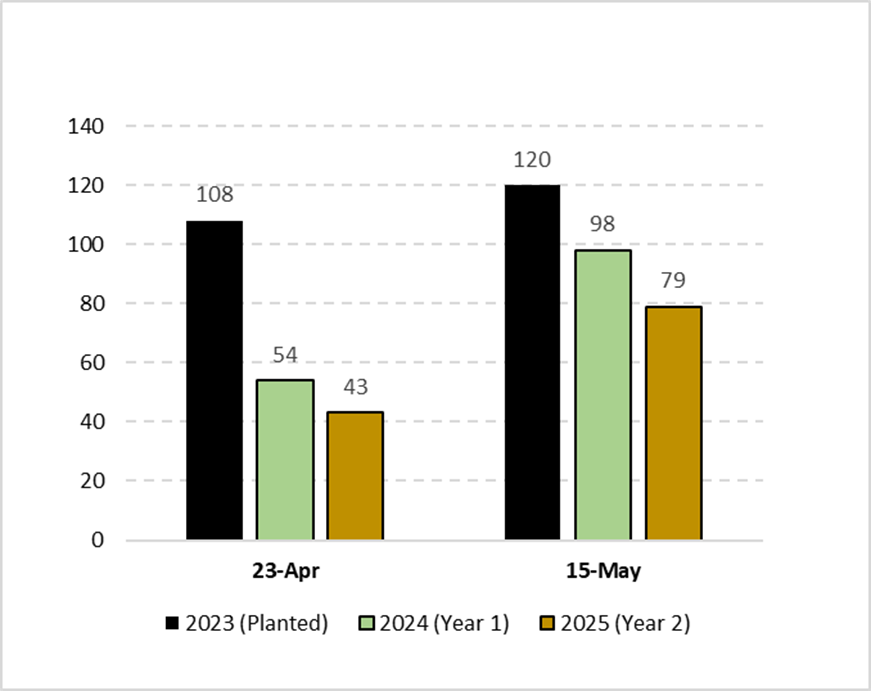
There were also significant differences in returns controlled for propagule size. 2025 results at Delaware Valley Ramps existing ramps lands ranged from 46% for 1/4" bulb segment to 71% for 1/2" bulb segment for combined early- and late-stage ramps. This was down from 56% for 1/4" bulbs and 75% for 1/2" bulbs in 2024.
Delaware Valley Ramps Results for returns by propagule size for existing ramp lands treatment plots
PSU also found larger propagule size had better returns. 2025 results ranged from 36% for 1/4" bulb segment to 70% for 1/2" bulb segment for combined early- and late-stage ramps. This was down from 50% for 1/4" bulbs and 82% for 1/2" bulbs in 2024.
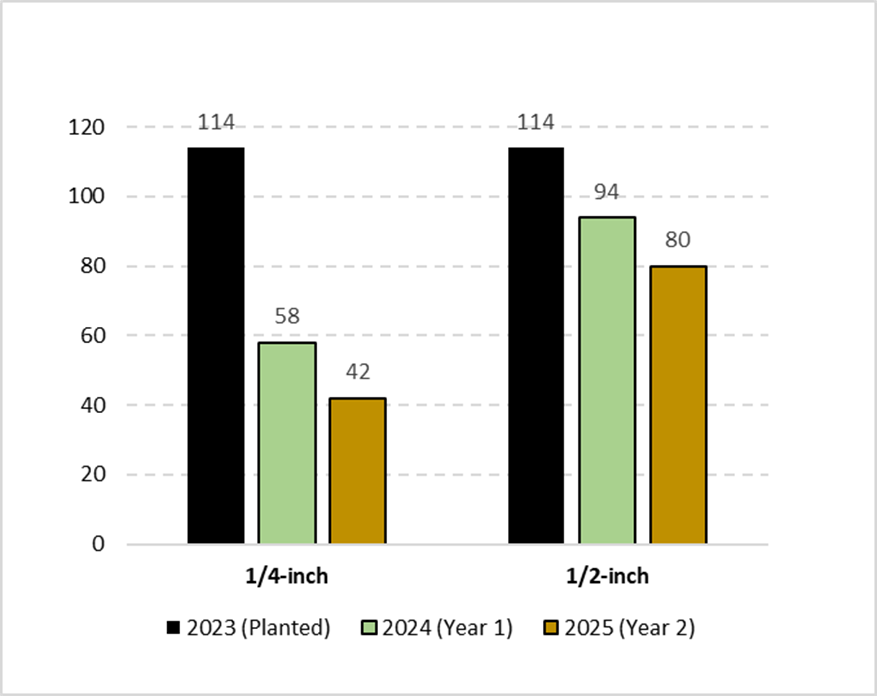
There was no significant difference in emergence between propagules that were originally 2 leaf plants vs. 3 leaf plants. The original 2 and 3 leaf plants were on average about the same length and weight. This variable was introduced as we normally expect 3 leaf plants to be more likely to be of reproductive age than 2 leaf plants though we often see 2 leaf plants producing flowers and seeds.
Delaware Valley Ramps Results for returns by propagule number of leaves for existing ramp lands treatment plots
Though we planted 2 and 3 leaf plants, for both root plate and bulb segments propagules as well as whole bulbs, almost all of the 2025 emerging plants across all treatments had one or two leaves. PSU also found that most of the returning plants in 2025 had two leaves. The plants did approach the stature of natural plants growing nearby as opposed to 2024 growing season when the emerging specimens were noticeably shorter in stature. This will be discussed below and may be the result of an abnormally wet and cold spring.
While we controlled for the number of leaves of mixed color stem harvested plants, PSU controlled for stem color. PSU found that green stemmed plants had better returns than red stemmed plants. Red stemmed plants showed a 47% return in 2025 and green stemmed plants showed a 60% return. This was down from 55% for red stemmed plants in 2024 and 78% for green stemmed plants.
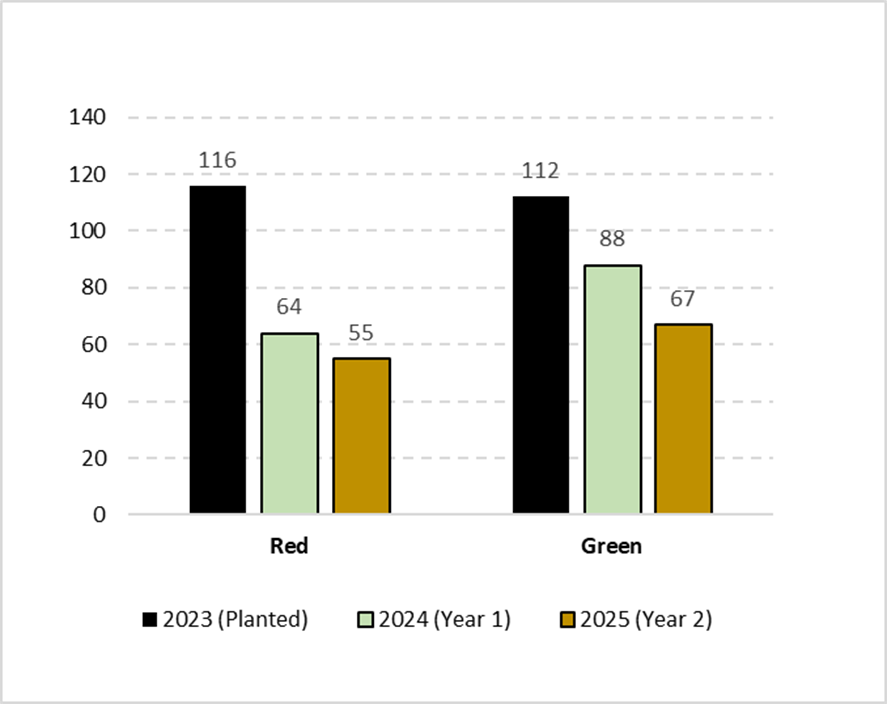
One of the goals of the study was to see how long it would take for the plants to reach reproductive stage. While it was assumed that all plants harvested for the study were of reproductive stage it was not known what the outcome would be after the treatments and transplanting. In 2024, none of the plants flowered or produced seeds. In 2025, six of the plants across 3 of the plots reached maturity and produced flowers and seeds. All of these were from the late harvest transplants, 5 with 3 leaves and 1 with 2 leaves and 4 of these had 1/2" propagules and 2 had 1/4" propagules. PSU found no flowering or fruiting plants in either year.
Our original weights and measures of the ramp plants transplanted confirmed that late harvested plants were a little longer and weighed significantly more than early harvested plants and that ramp propagules weighed significantly more for late harvested plants than early harvested plants. Harvest was about two weeks later for late harvested plants (5/11/23) than early harvested plants (4/25/23).
For example, early two leaf plants averaged 28.7 cm (11.28 inches) in length and weighed 7.8 grams and the propagule size averaged 1.9 grams. Early three leaf plants averaged 28.194 cm (11.1 inches) in length and weighed 10 grams and the propagule size averaged 2.5 grams. Late two leaf plants averaged 31.5 cm (12.4 inches) in length and weighed 12.06 grams and the propagule size averaged 4 grams. Late three leaf plants averaged 29.5 cm (11.6 inches) in length and weighed 13.4 grams and the propagule size averaged 4.2 grams.
Whole bulbs from late harvest averaged 6.2 grams for two leaf plants and 6.8 grams for 3 leaf plants.
In 2025 at the peak of the season we gently harvest a small sample of plants to weigh and measure them. We harvested 3 of the whole bulb transplants and 3 of the partial bulb late season transplants. These plants were than replanted to continue to track flowering and fruiting of the transplants. We found that the partial bulb transplants average 9.3 grams and 29.2 cm. (11.5 inches) and the whole bulb transplants 12 grams and 36 cm. (14.2 inches). This indicates that in 2025, from this small sample, the transplants had not yet reached the stature of the original plants.
The 2025 growing season had unusually wet and cool conditions. At the Delaware Valley Ramps site it rained 12 inches in April and May. This led to a delay in the emergence of the plants, smaller growth of all natural plants and an early onset of senescence across the ramp grounds. This may have led to some of the findings such as the paucity of 3 leaved plants as compared to the 2024 data even among propagules that were originally 3 leaved plants.
We did find during the first growing season that two of the plots in the non-ramp producing lands contained concentrations of hay scented ferns. Ramps planted in these areas showed the least robust returns over both growing seasons. While there are places in the ramp producing lands that are co-habited by hay scented ferns they may have established after the ramps had established there and we do not know the impact of introducing ramps where hay scented ferns have already established.
This study was designed to assess the feasibility of replanting the root plates of ramps with a small segment of the bulb attached to determine if the plant can be consumed while propagating a new plant. The study controlled for maturity of original plant, size of bulb segment, number of leaves of original plant and stem color of original plant. It was replicated across two sites.
The study found that this method is feasible with significant success depending on the treatment type. Late maturity plants with larger bulb segments showed the most success and robust subsequent growth and biomass.
Education & outreach activities and participation summary
Participation summary:
Outreach Activities
We issued a press release on March 30, 2023 announcing the awarding of the grant and the commencement of the research project. It was picked up in the Sullivan County Democrat, a local weekly newspaper, on 4/28/23.
We presented on sustainable management of ramp lands in a panel entitled "Native Plants for Farms & Everywhere Else" at the 2024 PASA conference on February 8, 2024. The objectives and scope of this SARE funded project were included in the presentation. It was well attended and generated follow-up interest.
Here is the PowerPoint from that presentation:
PASA Native Plants for Farms and Everywhere Else - DVR- 2-8-24 - 16-9
We organized and presented two educational ramp webinars (that discussed this project in part) with partners at Penn State University extension. Each of these had more than 500 registrants who received a recording and there were more than 150 live attendees at each.
Here is the PowerPoint from that presentation.
Sustainably managing ramp lands - DVR- 4-10-25- 16-9
We also presented on ramp forest farming in Eric Burkhart's Penn State Agroforestry class (FOR 418) on April 3, 2024. The objectives and scope of this SARE funded project were included in the presentation.
Sustainably managing ramp lands - DVR- 4-2-24 - 16-9
During the course of the research project we hosted Ramps U-Pick on the Delaware Valley Ramps property. Over the three years of the study we scheduled 75 sessions and had over 125 participants. At each session we brought the participants to one of the trial sites to explain the research project.
In September of this year, we are hosting an onsite workshop for members of the Northeast Forest Farmers Coalition to discuss this research project as well as to explore ramp seed production and transplanting of dormant bulbs.
In October of this year, we are scheduled to present to the Tusten Social Sage Sessions, an Upper Delaware River Watershed group of older engaged adults, on the research and managing ramp lands.
We have a workshop proposal submitted to PASA for a presentation on the results of the study at its 2026 conference.
Learning Outcomes
We have presented the findings in both professional and consumer-oriented venues. Participants have reported that they either plan to try this methodology or have already employed it with success. However, in most cases, people have employed this method have planted the transplants without any method of tracking the number planted or the outcomes. Key changes we have observed are that participants plan to more closely track the outcomes and important measures such as time to flowering and fruiting maturity.
Project Outcomes
Delaware Valley Ramps has always tracked the plants in the ramp lands throughout the year, monitoring phenology, flowering, fruiting, and range. We have increasingly emphasized to others that it is important to revisit ramp lands throughout the year to do the same. Most people only visit their ramp lands during the short 4 week harvest season.
One outcome of this is that we will be presenting an onsite workshop to members of the Northeast Forest Farmers Coalition in September 2025 that specifically explores ramp seed production and harvesting of dormant bulbs to give participants some insight into reproduction in addition to the transplant methods contained in this study. We hope that participants will learn about all of the ways they can improve their ramp land yields through transplants in addition to management of the forest lands.
Anecdotally we know of consumers and other farmers who are already using this method. We will write up a methodology for replanting root plates with bulb segments as a consumer tool and offer it to ramp farmers and farmers market operators for consumer education. The tool will include a link to a survey site to allow consumers and farmers to report on their success.
While we found some transplants reached maturity over two growing seasons we plan to continue to collect data on these plots over coming seasons to further assess time to maturity. Ramps may have a life span in the wild of ten or more years. Will the transplants mature over a full ten years or will they be limited to a total life span that includes the life of the original plant?
At Delaware Valley Ramps the treatment plots in existing and transitional ramp lands showed the greatest success and the treatment plots in new lands showed much less success. We would like to replicate the study in new ramp lands with better prepared plots, removing not only brush but digging up the plots to remove other plants such as hay scented ferns.
The finding of Penn State on the greater success of green vs. red stemmed plants is a surprise and merits further study.
We are continuing to seek ramp farmers in other geographic regions who are interested in further replicating the study to explore any regional differences.
We believe there might also be value in tracking individual plants through the study methodology to explore the growth after transplant in weight and length as opposed to tracking classes of plants.
Penn State (Eric Burkhart) plans to apply for grant funding to further study some of the factors associated with this practice and replicate the study more broadly with landowners and growers. While this funding is pursued, we will collect data in year 3 (2026) and then use these results to draft a scientific manuscript that will be submitted to a peer-reviewed journal on the results of the current three-year study, the first two years of which were funded by SARE. Our hope is to solidly establish the viability of this re-plant practice and spread the word regarding best practices via publications and webinars/workshops in 2026 and beyond.
